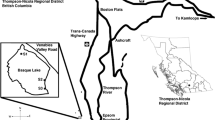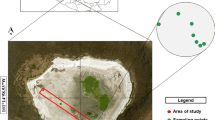Abstract
The microbial ecology of karstic ground water is largely unknown. The density, activity, and diversity of bacteria indigenous to subsurface karstic material in Mammoth Cave National Park, Mammoth Cave, Kentucky were studied using minimally disruptive, on-site procedures. Two sites, located 100 m below the surface and consisting of saturated fine to coarse sand in pooled water, were examined. Samples were taken aseptically using modified, sterile 60-cc syringes. Total cell and total respiring cell densities were determined using an acridine orange/p-iodonitrotetrazolium violet (AO/INT) staining procedure. Cells in selected cores were stained with INT and incubated in the cave for 4 h prior to fixing with glutaraldehyde and subsequent transport to the laboratory. Cells were stained with AO in the laboratory. Low- and high-nutrient media were used to determine viable cell counts. Plates were incubated in the cave for 1 day at ambient temperature prior to transportation to the laboratory in an insulated cooler. Viable cell counts ranged from 1.0 × 106 to 8.1 × 106 cells wet g−1 of sediment. Total direct counts were 3.9 × 106 and 1.4 × 107 cells wet g−1 for the Olivia's Dome and the Catherine's Dome sites, respectively. Viable cell counts were highly similar to respiring cell counts at both sites. At the Olivia's Dome site, viable cell counts represented 26–31% of the direct cell counts, while 58% of the total cell count were actively respiring. At the Catherine's Dome site, viable cell counts represented 11–58% of the direct counts, while 53% of the cells were actively respiring. A total of 237 strains recovered from low- and high-nutrient media at both Olivia's and Catherine's Domes, and 10 reference strains were examined for 117 morphological, biochemical, and physiological characteristics. Results were coded in a binary fashion and analyzed using numerical taxonomic techniques. Similarity values were calculated using a simple matching coefficient. Fifty-two clusters, ranging in size from 2 to 13 members, were defined at the 80–85% similarity level with the weighted pair-group mathematical average algorithm (WPGMA). The matrix was examined using the Jaccard coefficient and WPGMA clustering to control for distortion due to negative matches and varying group size. Presumptively identified genera include, Arthrobacter, Brevibacterium, Bacillus, Cornyebacterium, Actinomyces, Aureobacterium, Chromobacterium, and Mycobacterium. Pseudomonas spp. were not recovered. Fifty percent of the clustered operational taxonomic units (OTUs) were not identified. Thirty percent of the clustered OTUs were irregular, asporogenous, Gram-positive rods. The bacterial communities varied between sites, and isolation medium had a strong influence on the strains recovered. The bacterial community in the karstic sediments sampled exhibits a high degree of diversity having no dominant strain or strains.
Similar content being viewed by others
References
Alexander M (1977) Introduction to soil microbiology, 2nd ed. John Wiley & Sons, New York
Balkwill DL (1989) Numbers, diversity, and morphological characteristics of aerobic, chemolithotrophic bacteria in deep subsurface sediments from a site in South Carolina. Geomicrobiol 7:33–52
Balkwill DL (1990) Deep-aquifer microorganisms. In: Labeda DP (ed) Isolation of biotechnological organisms from nature. McGraw-Hill, New York
Balkwill DL, Ghiorse WC (1985) Characterization of subsurface bacteria associated with two shallow aquifers in Oklahoma. Appl Environ Microbiol 50:580–588
Beloin RM, Sinclair JL, Ghiorse WC (1988) Distribution and activity of microorganisms in subsurface sediments of a pristine study site in Oklahoma. Microb Ecol 16:85–97
Bone TL, Balkwill DL (1988) Morphological and cultural comparison of microorganisms in surface soil and subsurface sediments at a pristine study site in Oklahoma. Microb Ecol 16:49–64
Brock TD, Passman F, Yoder I (1973) Absence of obligately psychrophilic bacteria in constantly cold springs associated with caves in southern Indiana. Amer Midl Nat 90:240–246
Caumartin V (1963) Review of the microbiology of underground environments. Bull Nat Speleol Soc 25:1–14
Colwell RR, Weibe WJ (1970) “Core” characteristics for the use in classifying aerobic, heterotrophic bacteria by numerical taxonomy. Bull Ga Acad Sci 28:165–185
10. Cowen ST, Steel KJ (1965) Manual for the identification of medical bacteria. University Press, Cambridge
Cox G, James JM, Legget KEA, Armstrong R, Osborn L (1989) Cyanobacterially deposited speleothems: subaerial stromatolites. Geomicrobiol J 7:245–252
Danielli HMC, Eddington MM (1983) Bacterial calcification in limestone caves. Geomicrobiol J 3:1–16
Dyson HJ, James JM (1981) The incidence of iron bacteria in an Australian cave. In: Beck BF (ed) Proceed Int Congr Speleol 8:79–81
Federle TW, Dobbins DC, Thorton-Manning JR, Jones DD (1986) Microbial biomass, activity, and community structure in subsurface soils. Ground Water 24:365–374
Fetter CW (1988) Applied hydrogeology, 2nd ed. Merrill Publishing Company, Columbus
Finegold SM, Baron EJ (1986) Bailey and Scott's diagnostic microbiology, 7th ed. CV Mosby Co., Saint Louis
Fliermans CB, Schmidt EL (1977) Nitrobacter in Mammoth Cave. Int J Speleol 9:1–19
Fredrickson JK, Garland TR, Hicks RJ, Thomas JM, Li SW, McFadden KM (1989) Lithotrophic and heterotrophic bacteria in deep subsurface sediments and their relation to sediment properties. Geomicrobiol J 7:53–66
Fredrickson JK, Balkwill DL, Zachara JM, Li S-MW, Brockman FJ, Simmons MA (199l) Physiological diversity and distributions of heterotrophic bacteria in deep Cretaceous sediments of the Atlantic coastal plain. Appl Environ Microbiol 57:402–411
Fung DYC, Hartman PA (1975) Miniaturized microbiological techniques for rapid characterization of bacteria. In: Heden C-G, Illem T (ed) New approaches to the identification of microorganisms. John Wiley & Sons, New York
Ghiorse WC, Balkwill DL (1983) Enumeration and morphological characterization of bacteria indigenous to subsurface sediments. Dev Ind Microbiol 24:213–224
Ghiorse WC, Wilson JT (1988) Microbial ecology of the terrestrial subsurface. Adv Appl Microbiol 33:107–172
Gounot A-M (1969) Contribution à l'étude des batteries des grottes froides. Int Speleol Cong V 5:1–6
Gvozdetskii NA (1967) Occurrence of karst phenomena on the globe and problems of their typology. Earth Res 7:98–127
Hauxhurst JD, Kaneko T, Atlas RM (1981) Characteristics of bacterial communities in the Gulf of Alaska. Microb Ecol 7:167–182
Horowitz A, Krichevsky MI, Atlas RM (1983) Characteristics and diversity of subarctic marine oligotrophic, stenoheterotrophic, and euryheterotrophic bacterial populations. Can J Microbiol 29:527–535
Hugh R, Liefson E (1953) The taxonomic significance of fermentative versus oxidative metabolism of carbohydrates by various Gram-negative bacteria. J Bacteriol 66:24–26
Jayne-Williams DJ (1975) Miniaturized methods for the characterization of bacterial isolates. J Appl Bacteriol 38:305–309
Jones RE, Beeman RE, Suflita JM (1989) Anaerobic metabolic processes in the deep terrestrial subsurface. Geomicrobiol J 7:117–130
Klute A (1986) Methods of soil analysis, part 2: chemical and biological methods, 2nd ed. Amer Soc Agron Soil Sci Soc Am, Madison, Wis.
Kolbel-Boelke J, Anders E-M, Nehrkorn A (1988) Microbial communities in the saturated groundwater environment II: diversity of bacterial communities in a Pleistocene sand aquifer and their in vitro activities. Microb Ecol 16:31–48
Kolbel-Boelke J, Tienken B, Nehrkorn A (1988) Microbial communities in the saturated ground-water environment I: methods of isolation and characterization of heterotrophic bacteria. Microb Ecol 16:17–29
Krieg NR, Holt JG (1984) Bergy's manual of systematic bacteriology, vol 1. Williams & Wilkins, Baltimore
Lavoie KH (1981) Invertebrate interactions with microbes during the successional decomposition of dung. Proc Int Cong Speleol 13:265–266
Lovelace TE, Colwell RR (1968) A multipoint inoculator for petri dishes. Appl Microbiol 16:944–945
Madsen EL, Bollag J-M (1989) Aerobic and anaerobic microbial activity in deep subsurface sediments from the Savannah River Plant. Geomicrobiol J 7:93–101
Mallory LM, Sayler GS (1983) Heterotrophic bacterial guild structure: relationship to biodegradative populations. Microb Ecol 9:41–55
Mills AL, Wassel RA (1980) Aspects of diversity measurement for microbial communities. Appl Environ Microbiol 40:578–586
Moeller V (1955) Simplified tests for some amino acid decarboxylases and for the arginine dehydrolase system. Acta Pathol Microbiol Scand 36:158–172
Olsen RA, Bakken LR (1987) Viability of soil bacteria: optimization of the plate-counting technique. Microb Ecol 13:59–74
41. Palmer AN (1981) A geological guide to Mammoth Cave National Park. Zephyrus Press, Teaneck, N.J.
Palmer AN (1989) Geomorphic history of the Mammoth Cave system. In: White WB, White EL (ed), Karst hydrology: concepts from the Mammoth Cave area. Van Nostrand Reinhold, New York
Quinlan JF, Ray JA (1989) Groundwater basins in the Mammoth Cave region, Kentucky. Friends of the Karst, Mammoth Cave, Kentucky
Sinclair JL, Ghiorse WC (1989) Distribution of aerobic bacteria, protozoa, algae, and fungi in deep subsurface sediments. Geomicrobiol J 7:15–31
Sneath PHA, Sokal RR (1973) Numerical taxonomy: the principles and practices of numerical classification. W. H. Freeman and Company, San Francisco
Sneath PHA, Mair NS, Sharpe ME, Holt JG (1986) Bergy's manual of systematic bacteriology, vol 2. Williams & Wilkins, Baltimore
Starr MP, Stolp H, Truper HG, Balows A, Schlegel HG (1981) The prokaryotes, vols 1 and 2. Springer-Verlag, Berlin
Stevenson IL (1967) Utilization of aromatic hydrocarbons by Arthrobacter spp. Can J Microbiol 13:205–211
Webster JJ, Hampton GJ, Wilson JT, Ghiorse WC, Leach FR (1985) Determination of microbial cell numbers in subsurface samples. Ground Water 23:17–25
White DC, Nickles JS, Parker JH, Findlay RH, Gehron MJ, Smith GA, Martz RF (1985) Biochemical measures of biomass, community structure, and metabolic activity of the ground water microbiota. In: Ward CH, Giger W, McCarty PL (eds) Ground water quality. John Wiley & Sons, New York
White EL (1989) Flood hydrology. In: White WB, White EL (eds) Karst hydrology: concepts from the Mammoth Cave area. Van Nostrand Reinhold, New York
White WB (1988) Geomorphology and hydrology of karst terrains. Oxford University Press, New York
White WB (1989) Introduction to the karst hydrology of the Mammoth Cave area. In: White WB, White EL (eds) Karst hydrology: concepts from the Mammoth Cave area. Van Nostrand Reinhold, New York
Wilson JY, McNabb JF, Balkwill DL, Ghiorse WC (1983) Enumeration and characterization of bacteria indigenous to a shallow water-table aquifer. Ground Water 21:134–142
Author information
Authors and Affiliations
Additional information
Correspondence to: K.J. Rusterholtz
Rights and permissions
About this article
Cite this article
Rusterholtz, K.J., Mallory, L.M. Density, activity, and diversity of bacteria indigenous to a karstic aquifer. Microb Ecol 28, 79–99 (1994). https://doi.org/10.1007/BF00170249
Received:
Revised:
Issue Date:
DOI: https://doi.org/10.1007/BF00170249




